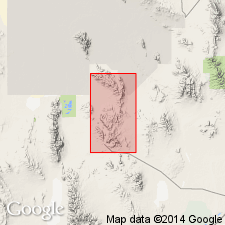
- Usage in publication:
-
- Trailer limestone*
- Modifications:
-
- Named
- Dominant lithology:
-
- Limestone
- AAPG geologic province:
-
- Great Basin province
Summary:
Named for exposures in Trailer Wash, T11S, R11W, southeast Dugway Range, Juab Co, UT in the Great Basin province. Type section measured along narrow ridge 0.6 mi north of wash. Crops out also on east side Dugway Range, in knolls 1 mi east of Dugway Pass, south end Fandangle Canyon, ridge at south end of Bullion Canyon, and two hillsides 1.4 mi south-southeast of Four Metals Mine. Extends north into Tooele Co. In lower 150 ft consists of massive to thick-bedded, dark blue-gray limestone with the alga GIRVANELLA and white calcite stringers. Upper part is dark blue-gray, very fine grained limestone in beds 1/2 to 2 in thick separated by tan or yellow argillaceous partings. Locally weathered surfaces of bedding planes in upper part have a crinkled appearance, and small dark-brown cubes of limonite pseudomorphous after pyrite. Is 384 ft thick at type where it overlies Shadscale formation (new) and underlies Fandangle limestone (new). Thickens southward. Fossils in upper part include worm tubes?, scattered trilobite. Probably equivalent to Herkimer, Geddes, upper part Pole Canyon, Bowman, and Maxfield limestones. Of Middle Cambrian age. Geologic map. Stratigraphic section.
Source: GNU records (USGS DDS-6; Denver GNULEX).
For more information, please contact Nancy Stamm, Geologic Names Committee Secretary.
Asterisk (*) indicates published by U.S. Geological Survey authors.
"No current usage" (†) implies that a name has been abandoned or has fallen into disuse. Former usage and, if known, replacement name given in parentheses ( ).
Slash (/) indicates name conflicts with nomenclatural guidelines (CSN, 1933; ACSN, 1961, 1970; NACSN, 1983, 2005, 2021). May be explained within brackets ([ ]).

